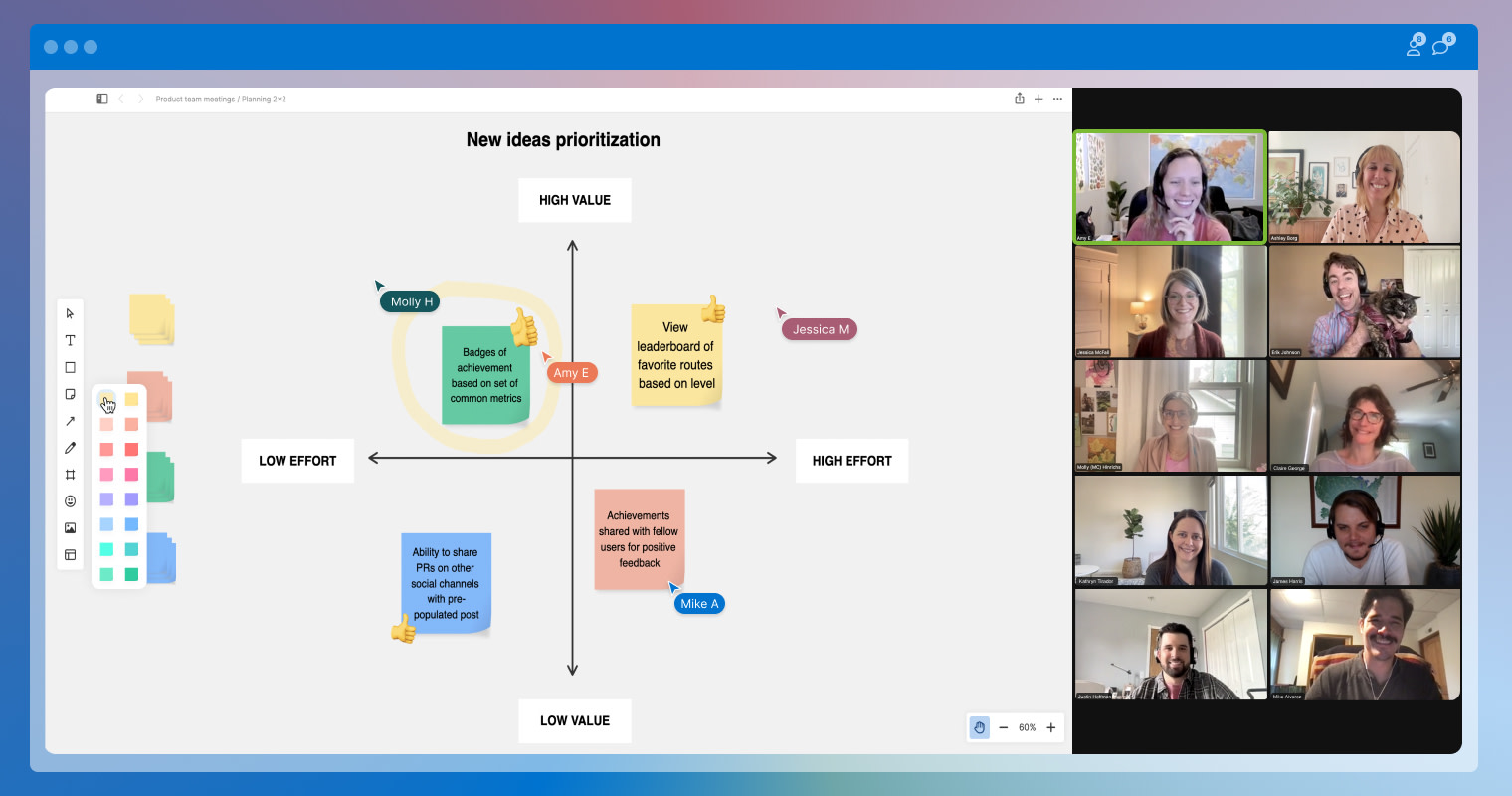
Members of the Aha! team using a 2x2 prioritization matrix to collaborate | Photo by Aha!
4 Brainstorming Tactics Every Product Team Should Follow
Are you innately innovative? You might not consider yourself particularly creative or visionary. But research shows that coming up with great ideas is a skill that anyone can learn and develop. We can all ideate better with the right knowledge, tools, and techniques. This is especially important for product development teams who need proven ways to think through complex problems.
The pace of innovation (especially in technology products) is crushingly fast. In order to keep up, product teams must be constantly ideating to deliver novel solutions to customers.
The problem is that most teams still rely on old-fashioned approaches to accomplish this — jumping on calls, spitballing ideas, and descending into long email chains. These methods tend to fail when they lack a clear purpose or structure. It is easy for folks to get distracted. Lots of ideas are thrown out but nothing impactful materializes.
Product teams need to think and collaborate in richer and more nuanced ways. Thinking visually is one key way to accomplish this. Research from Harvard University shows that using specific types of visualizations (such as diagrams, matrices, trees, and networks) can increase comprehension and recall for viewers. From my experience, the process of visualization has even greater benefits.
Thinking visually allows you to communicate important information quickly. It forces you to distill the problems you are trying to solve and consider them through different lenses.
Most product teams already rely on diagrams, mindmaps, and other visual tools to sketch out ideas. But many struggle with how to leverage these tools to actually deliver more value to customers and the business. A visualization by itself is useless — it is a vehicle for aligning the team around a shared mental model of what you are trying to accomplish. The process of clarifying assumptions, discussing alternatives, and identifying blockers is what makes thinking visually effective.
This is what pushed us to build Aha! Create. (Editor's note: Aha! Create is now Aha! Notebooks. See what is new.) Our product teams wanted better ways to ideate, work through concepts collaboratively, and link work directly to the roadmap. Now our customers are able to experience the benefits of more robust visual thinking — delivering bolder ideas and faster innovation.
Here are four ways to uplevel your own visual thinking so you can arrive at more dynamic concepts and solutions more quickly:
Clarify purpose
Why are you creating this visualization in the first place? Your aim might be to define a product goal, come up with new ideas for features, or understand a customer need more deeply. Map out your objectives with teammates upfront and clarify any assumptions and expectations. Looking at a single, shared visual quickly aligns everyone around what you are trying to accomplish.
Define scope
Now it is time to organize your thoughts at the right level of abstraction. This means only focusing on the concepts that are relevant to the specific problem you are trying to solve. Say your product team is sketching out a user flow diagram to identify ways to improve the customer experience. Although it can be easy to get distracted by tangential details — such as the color or design of individual buttons on an individual webpage — use your visualization as a cue to keep the discussion on track. Some teams use a mind map to orient around a central topic and its relationship to other relevant ideas.

Elicit participation
Product building is cross-functional by nature — each group in the organization has valuable insights to contribute to your visual thinking exercises. Whether you are trying to determine how to best solve a customer problem or make team workflows more efficient, invite your colleagues from product management, engineering, product marketing, customer support, and more to capture their perspectives and knowledge visually in one place. This collaboration makes it easy to spot any conflicting assumptions, mismatched priorities, and potential areas of friction between teams (such as product and engineering, for example).
Share widely
Once you have your visualizations, use them to spark meaningful discussions with the rest of the organization. For instance, you can present high-level diagrams (think prioritization matrices and SWOT analyses) to executives and customer-facing groups to show the value of your ideas. Or you can share a customer journey map with members of marketing, sales, and customer support teams to elicit feedback on how to improve the overall customer experience. Tailor the visualization to your specific audience — or, even better, use an interactive visual tool that viewers can update in real time.

Visual thinking is inclusive and empowering — when done right, it aligns the entire team around a shared vision for how you will deliver greater value to customers.
Successful product development relies on a constant stream of new ideas. Adding visual thinking to your team's workflows can certainly help you boost creativity and innovate faster. But the real benefits come when you understand why, when, and how to use these visualizations effectively. You will drive deeper discussions and foster closer collaboration as the team works together to build products that customers love.
Anything is possible with the world's #1 product development software. Start a free trial today.




